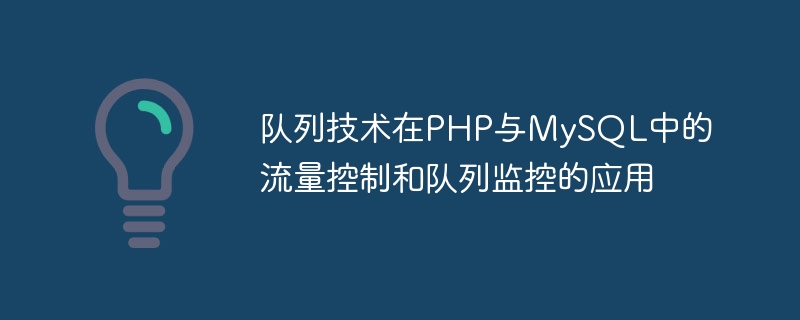

Application of queue technology in flow control and queue monitoring in PHP and MySQL
With the rapid development of the Internet, many websites and applications face high concurrent access The problem. In order to deal with this problem, queue technology came into being. Queue is a data structure based on the first-in-first-out principle and is often used for asynchronous processing and flow control.
As a popular server-side language, PHP is widely used in website development combined with MySQL database. This article will introduce the application of queue technology in flow control and queue monitoring in PHP and MySQL, and give specific code examples.
In the case of high concurrent access, the server may not be able to process all requests immediately, resulting in excessive server load. At this time, you can use the queue to relieve the pressure, add the requests to the queue in order, and then process them one by one.
In PHP, we can use Redis as a queue server by connecting to a Redis instance, using the lpush command to add requests to the queue, and using the rpop command to remove requests from the queue and process them. The following is a simple PHP sample code:
connect('127.0.0.1', 6379); // 将请求加入队列 $redis->lpush('request_queue', 'http://example.com/request1'); $redis->lpush('request_queue', 'http://example.com/request2'); // 从队列中取出请求并进行处理 while ($request = $redis->rpop('request_queue')) { // 处理请求的代码 echo "Processing request: " . $request . " "; } ?>
In the above code, we first connect to the Redis instance, then use the lpush command to add two requests to the queue, and then use the rpop command to take the request from the queue and process it. deal with. You can set up a loop to continuously process requests in the queue according to actual needs.
In addition to flow control, queue technology can also be used for queue monitoring. In practical applications, we can perform performance analysis and optimization by monitoring the length and processing speed of the queue.
In MySQL, we can create a special queue table to store queue elements and use scheduled tasks to monitor the queue. The following is a simple MySQL sample code:
-- 创建队列表 CREATE TABLE `queue` ( `id` INT AUTO_INCREMENT PRIMARY KEY, `data` VARCHAR(255) NOT NULL, `status` ENUM('new', 'processing', 'completed') NOT NULL DEFAULT 'new', `created_at` TIMESTAMP DEFAULT CURRENT_TIMESTAMP ); -- 定时任务,每分钟输出队列元素数量和平均处理速度 CREATE EVENT `queue_monitor` ON SCHEDULE EVERY 1 MINUTE DO BEGIN DECLARE queue_length INT; DECLARE processing_speed DECIMAL; -- 查询队列表中元素数量 SELECT COUNT(*) INTO queue_length FROM `queue`; -- 查询队列表中平均处理速度 SELECT COUNT(*) / TIMESTAMPDIFF(SECOND, MIN(`created_at`), MAX(`created_at`)) INTO processing_speed FROM `queue` WHERE `status` = 'completed'; -- 输出结果 SELECT CONCAT('Queue length: ', queue_length) AS '队列长度', CONCAT('Processing speed: ', processing_speed) AS '平均处理速度'; -- 清理已完成的队列元素 DELETE FROM `queue` WHERE `status` = 'completed'; END; -- 插入队列元素 INSERT INTO `queue` (`data`) VALUES ('data1'), ('data2'), ('data3'), ('data4'); -- 更新队列元素状态为已处理 UPDATE `queue` SET `status` = 'completed' WHERE `id` = 1;
In the above code, we first create a queue table namedqueue, containing the id, data, status and created_at fields. Then we created a scheduled task namedqueue_monitorto output the queue length and average processing speed every minute.
You can set the execution frequency and output content of scheduled tasks according to actual needs. The above code is only an example, and actual application may need to be designed according to specific business logic.
Summary:
Queue technology is widely used in flow control and queue monitoring in PHP and MySQL. Through queue technology, we can effectively relieve server pressure and achieve flow control and queue monitoring. I hope this article will be helpful in understanding the application of queue technology in PHP and MySQL, and provides specific code examples.
The above is the detailed content of Application of queue technology in flow control and queue monitoring in PHP and MySQL. For more information, please follow other related articles on the PHP Chinese website!
 How to retain two decimal places in c++
How to retain two decimal places in c++ flac file conversion
flac file conversion How to register a permanent website domain name
How to register a permanent website domain name How to install chatgpt on mobile phone
How to install chatgpt on mobile phone java
java The difference between vue2 and vue3 two-way binding
The difference between vue2 and vue3 two-way binding The difference between currentregion and usedrange
The difference between currentregion and usedrange The phone cannot connect to the Bluetooth headset
The phone cannot connect to the Bluetooth headset



